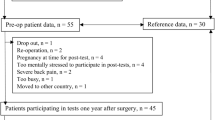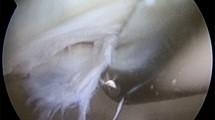Abstract
Purpose
Patients with femoroacetabular impingement syndrome (FAIS) are young and middle-aged persons living physically active lives including sports activities. However, measurements of the physical activity level before and after hip arthroscopic surgery in patients with FAIS using both self-reported and objective accelerometer-based measures are lacking. Furthermore, comparing patients with a reference group of persons reporting no hip problems and conducting subgroup analyses investigating changes in physical activity level and self-reported outcomes according to pre-surgery activity level may further highlight the activity pattern for patients.
Methods
Sixty patients with FAIS eligible for hip arthroscopic surgery were consecutively included in a prospective cohort study (HAFAI cohort) together with 30 reference persons reporting no hip problems. Participants completed the Copenhagen Hip and Groin Outcome Score (HAGOS) together with questions regarding their sports activities. Furthermore, participants wore a three-axial accelerometer for five consecutive days during waking hours. The accelerometer-based data were analysed and presented as total activity and type, frequency and duration of activities.
Results
Patients experienced significant and clinically relevant changes in all HAGOS scores. 88% of patients participated in some kind of sports activity 1 year after surgery. Overall, objectively measured physical activity did not change from before to 1 year after surgery. However, subgroup analyses of the most sedentary patients preoperatively revealed significant changes towards a more active pattern. Compared to reference persons, patients performed less bicycling and running.
Conclusion
Despite clinically relevant changes in self-reported outcomes, patients did not increase their overall physical activity level 1 year after surgery. Physical activity levels were lower in patients than in the reference group and patients continued bicycling and running less compared with the reference group.
Level of evidence
II.


Similar content being viewed by others
References
Diamond LE, Dobson FL, Bennell KL, Wrigley TV, Hodges PW, Hinman RS (2014) Physical impairments and activity limitations in people with femoroacetabular impingement: a systematic review. Br J Sports Med 49:230–242
Freke MD, Kemp J, Svege I, Risberg MA, Semciw A, Crossley KM (2016) Physical impairments in symptomatic femoroacetabular impingement: a systematic review of the evidence. Br J Sports Med 50:1180
Griffin DR, Dickenson EJ, O'Donnell J, Agricola R, Awan T, Beck M et al (2016) The Warwick Agreement on femoroacetabular impingement syndrome (FAI syndrome): an international consensus statement. Br J Sports Med 50:1169–1176
Harris-Hayes M, Steger-May K, Pashos G, Clohisy JC, Prather H (2012) Stride activity level in young and middle-aged adults with hip disorders. Physiother Theory Pract 28:333–343
Javed A, O'Donnell JM (2011) Arthroscopic femoral osteochondroplasty for cam femoroacetabular impingement in patients over 60 years of age. J Bone Joint Surg 93 B:326–331
Kemp JL, Collins NJ, Roos EM, Crossley KM (2013) Psychometric properties of patient-reported outcome measures for hip arthroscopic surgery. Am J Sports Med 41:2065–2073
Kemp JL, Risberg MA, Schache AG, Makdissi M, Pritchard MG, Crossley KM (2016) Patients with chondrolabral pathology have bilateral functional impairments 12–24 months after unilateral hip arthroscopy: a cross-sectional study. J Orthop Sports Phys Ther 46:947–956
Kierkegaard S, Langeskov-Christensen M, Lund B, Naal FD, Mechlenburg I, Dalgas U et al (2017) Pain, activities of daily living and sport function at different time points after hip arthroscopy in patients with femoroacetabular impingement: a systematic review with meta-analysis. Br J Sports Med 51:572–579
Kierkegaard S, Lund B, Dalgas U, Sorensen H, Soballe K, Mechlenburg I (2015) The Horsens–Aarhus Femoro Acetabular Impingement (HAFAI) cohort: outcome of arthroscopic treatment for femoroacetabular impingement. Protocol for a prospective cohort study. BMJ Open 5:e008952
Kierkegaard S, Mechlenburg I, Lund B, Rømer L, Søballe K, Dalgas U (2019) Is hip muscle strength normalised in patients with femoroacetabular impingement syndrome 1 year after surgery? Results from the HAFAI cohort. J Sci Med Sport 22:419–419
Kierkegaard S, Mechlenburg I, Lund B, Soballe K, Dalgas U (2017) Impaired hip muscle strength in patients with femoroacetabular impingement syndrome. J Sci Med Sport 20:1062–1067
Konan S, Rayan F, Meermans G, Witt J, Haddad FS (2011) Validation of the classification system for acetabular chondral lesions identified at arthroscopy in patients with femoroacetabular impingement. J Bone Joint Surg Br 93:332–336
Lipperts M, van Laarhoven S, Senden R, Heyligers I, Grimm B (2017) Clinical validation of a body-fixed 3D accelerometer and algorithm for activity monitoring in orthopaedic patients. J Orthop Transl 11:19–29
Lund B, Mygind-Klavsen B, Gronbech Nielsen T, Maagaard N, Kraemer O, Holmich P et al (2017) Danish Hip Arthroscopy Registry (DHAR): the outcome of patients with femoroacetabular impingement (FAI). J Hip Preserv Surg 4:170–177
Malviya A, Paliobeis CP, Villar RN (2013) Do professional athletes perform better than recreational athletes after arthroscopy for femoroacetabular impingement? Clin Orthop Relat Res 471:2477–2483
Notzli HP, Wyss TF, Stoecklin CH, Schmid MR, Treiber K, Hodler J (2002) The contour of the femoral head-neck junction as a predictor for the risk of anterior impingement. J Bone Joint Surg Br 84:556–560
Sansone M, Ahlden M, Jonasson P, Thomee C, Sward L, Ohlin A et al (2017) Outcome after hip arthroscopy for femoroacetabular impingement in 289 patients with minimum 2-year follow-up. Scand J Med Sci Sports 27:230–235
Sliepen M, Mauricio E, Lipperts M, Grimm B, Rosenbaum D (2018) Objective assessment of physical activity and sedentary behaviour in knee osteoarthritis patients—beyond daily steps and total sedentary time. BMC Musculoskelet Disord 19:64
Thorborg K, Holmich P, Christensen R, Petersen J, Roos EM (2011) The Copenhagen Hip and Groin Outcome Score (HAGOS): development and validation according to the COSMIN checklist. Br J Sports Med 45:478–491
Tudor-Locke C, Bassett DR Jr (2004) How many steps/day are enough? Preliminary pedometer indices for public health. Sports Med 34:1–8
Tönnis D (1987) Congenital dysplasia and dislocation of the hip in children and adults. Springer, Berlin
van Schooten KS, Rispens SM, Elders PJ, Lips P, van Dieen JH, Pijnappels M (2015) Assessing physical activity in older adults: required days of trunk accelerometer measurements for reliable estimation. J Aging Phys Act 23:9–17
Verlaan L, Bolink SA, Van Laarhoven SN, Lipperts M, Heyligers IC, Grimm B et al (2015) Accelerometer-based physical activity monitoring in patients with knee osteoarthritis: objective and ambulatory assessment of actual physical activity during daily life circumstances. Open Biomed Eng J 9:157–163
Wall PDH, Fernandez M, Griffin DR, Foster NE (2013) Nonoperative treatment for femoroacetabular impingement: a systematic review of the literature. PM&R 5:418–426
Wiberg G (1939) Studies on dysplastic acetabula and congenital subluxation of the hip joint with special reference to the complication of osteoarthritis. Exp., Norstedt, Stockholm
Funding
This study was funded by Gigtforeningen, The Health Research Fund for the Central Region of Denmark, Augustinus Fonden, Aase og Ejnar Danielsens Fond, Direktør Jacob Madsen og Hustru Olga Madsens Fond, Fonden til Lægevidenskabens Fremme, Familien Hede Nielsens Fond, Gurli & Hans Engell Friis Foundation and Horsens Regional Hospital.
Author information
Authors and Affiliations
Corresponding author
Ethics declarations
Conflict of interest
The authors declare that they have no competing interests.
Ethical approval
All procedures performed in studies involving human participants were in accordance with the ethical standards of the institutional and/or national research committee and with the 1964 Helsinki declaration and its later amendments or comparable ethical standards.
Informed consent
Informed consent was obtained from all participants.
Additional information
Publisher's Note
Springer Nature remains neutral with regard to jurisdictional claims in published maps and institutional affiliations.
Rights and permissions
About this article
Cite this article
Kierkegaard, S., Dalgas, U., Lund, B. et al. Despite patient-reported outcomes improve, patients with femoroacetabular impingement syndrome do not increase their objectively measured sport and physical activity level 1 year after hip arthroscopic surgery. Results from the HAFAI cohort. Knee Surg Sports Traumatol Arthrosc 28, 1639–1647 (2020). https://doi.org/10.1007/s00167-019-05503-5
Received:
Accepted:
Published:
Issue Date:
DOI: https://doi.org/10.1007/s00167-019-05503-5




